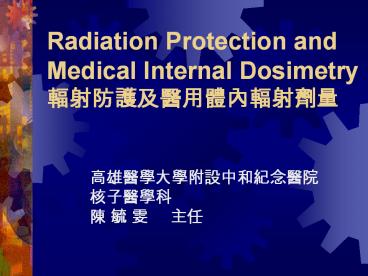Radiation Protection and Medical Internal Dosimetry ????????????? - PowerPoint PPT Presentation
1 / 16
Title:
Radiation Protection and Medical Internal Dosimetry ?????????????
Description:
Title: Radiation Protection and Medical Internal Dosimetry Author: Last modified by: NM240 Created Date – PowerPoint PPT presentation
Number of Views:239
Avg rating:3.0/5.0
Title: Radiation Protection and Medical Internal Dosimetry ?????????????
1
Radiation Protection and Medical Internal
Dosimetry ?????????????
- ?????????????? ?????
? ? ? ??
2
Pattern of Radiation Effect
- Exposure
- Contamination
3
Units of Radiation Dose
- Activity (A) Bq
- Radiation exposure C/kg
- Air kerama
- Absorbed dose (D) gray
- Equivalent dose (H) sievert LET
(linear energy transfer) - Effective dose (E)
4
Conversions of Units
5
Threshold Doses for Determininstic Effects in The
More Radiosensitive Tissues and Organs
6
Biological Effects of Exposure
- Nonstochastic effects
- Stochastic effects
7
Probability of Risk of Fatal Cancer between Age
and Sex
8
Dose in Medical Imaging
9
Annual Effective Dose Distribution in The World
10
Internal Dosimetry
- The method of calculating absorbed dose delivered
internally has been developed over many years by
the Medical Internal Radiation Dose (MIRD)
committee of the American Society of Nuclear
Medicine. - The aim of committee was to develop a dosimetry
system (MIRD schema) for diagnostic nuclear
medicine. However, the methods have also been
applied in radionuclide therapy and in internal
contamination.
11
MIRD Schema
- Source Organs vs Target Organs Dt s A
s St s - Cumulated activity, As
the total number of radioactive disintegrations
which occur in the sourve organ, and depends on
the activity administered the uptake of ,
retention by, and excretion from the organ and
thte physical decay of the radionuclide. - S-factors
have been tabulated for a variety of
radionuclides and for different source/target
configurations in both standard man and children.
12
Cumulated Activity
13
Flow Chart of MIRD Methology
14
S- Factors
- St s 1/ mi ? ?i ?i
- ?i equilibrium absorbed dose constant
- ?i absorbed fraction
- specific absorbed fraction (Monte Carlo
calculations)
15
Example
- Calculated the absorbed dose to the liver of an
adult patient who receives 3mCi (111MBq)
Tc99m-sulfur colloid for a liver scan, assuming
85 liver uptake with no excretion. - Answer
Weight of liver
1700 g (for a standard man)
A0 in the liver 3000 x 0.85
2550 u Ci (86.7 MBq) T e 6 hr
?i ?i
0.0806
- D 1.44 x (2550/1700) x 6 x 0.0806 1.04 rad
16
The limitations of the MIRD Methods
- Tabulated doses do not apply to all patients
- In the MIRD schema it is assumed that the
shape, size and position of the organs are s
prepresented by the standard, 70kg, hermaphrodite
human phantom. Disease organs can result in both
increased or decreased uptake of activiity and
changes in the residence time compared with
standard values so these factors sholud also be
considered when assessing the dose to patients.
- The MIRD schema claculates each dose to
- the target organs as an average, without
- permitting the determination of a maximum
- or minimum dose.

